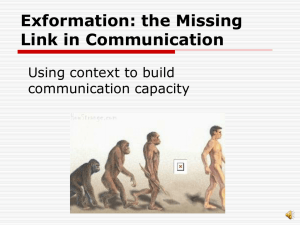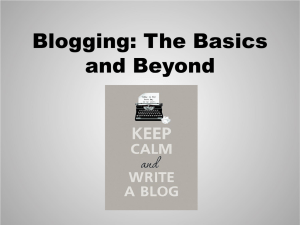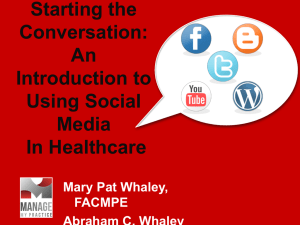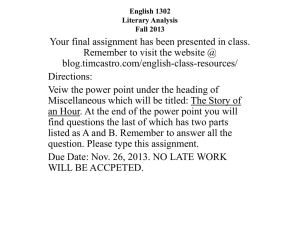theories idea
advertisement
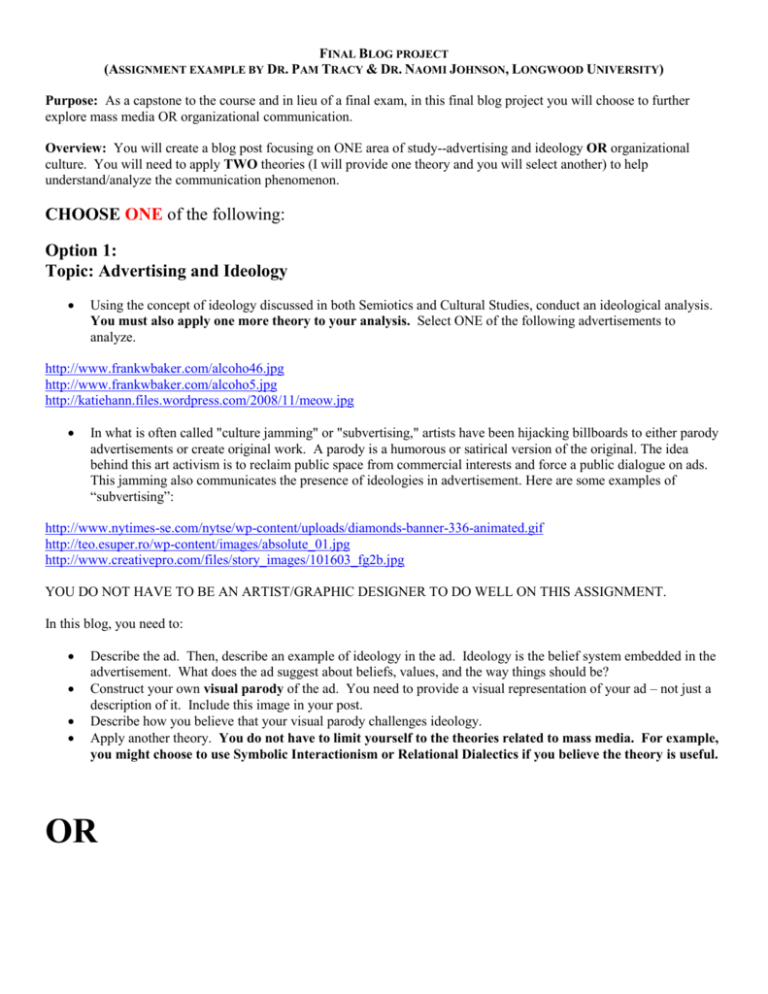
FINAL BLOG PROJECT (ASSIGNMENT EXAMPLE BY DR. PAM TRACY & DR. NAOMI JOHNSON, LONGWOOD UNIVERSITY) Purpose: As a capstone to the course and in lieu of a final exam, in this final blog project you will choose to further explore mass media OR organizational communication. Overview: You will create a blog post focusing on ONE area of study--advertising and ideology OR organizational culture. You will need to apply TWO theories (I will provide one theory and you will select another) to help understand/analyze the communication phenomenon. CHOOSE ONE of the following: Option 1: Topic: Advertising and Ideology Using the concept of ideology discussed in both Semiotics and Cultural Studies, conduct an ideological analysis. You must also apply one more theory to your analysis. Select ONE of the following advertisements to analyze. http://www.frankwbaker.com/alcoho46.jpg http://www.frankwbaker.com/alcoho5.jpg http://katiehann.files.wordpress.com/2008/11/meow.jpg In what is often called "culture jamming" or "subvertising," artists have been hijacking billboards to either parody advertisements or create original work. A parody is a humorous or satirical version of the original. The idea behind this art activism is to reclaim public space from commercial interests and force a public dialogue on ads. This jamming also communicates the presence of ideologies in advertisement. Here are some examples of “subvertising”: http://www.nytimes-se.com/nytse/wp-content/uploads/diamonds-banner-336-animated.gif http://teo.esuper.ro/wp-content/images/absolute_01.jpg http://www.creativepro.com/files/story_images/101603_fg2b.jpg YOU DO NOT HAVE TO BE AN ARTIST/GRAPHIC DESIGNER TO DO WELL ON THIS ASSIGNMENT. In this blog, you need to: Describe the ad. Then, describe an example of ideology in the ad. Ideology is the belief system embedded in the advertisement. What does the ad suggest about beliefs, values, and the way things should be? Construct your own visual parody of the ad. You need to provide a visual representation of your ad – not just a description of it. Include this image in your post. Describe how you believe that your visual parody challenges ideology. Apply another theory. You do not have to limit yourself to the theories related to mass media. For example, you might choose to use Symbolic Interactionism or Relational Dialectics if you believe the theory is useful. OR Option 2: Topic: Organizational culture Based on the concept of organizational culture as a system of shared meaning, how would you describe the culture at Longwood to a prospective student? You need to identify elements of the actual organizational culture an ethnographer would uncover. Be sure you touch upon metaphors, stories, and rituals. You must also apply one more theory to your analysis. In this blog, you need to: Describe Longwood University—remember your audience is prospective students. Describe and analyze with thick description relevant metaphors, stories, and rituals. Discuss one of each. Offer suggestions for improvement and/or cultural elements worth preserving. Apply another theory. You do not have to limit yourself to the theories related to organizational culture. For example, you might choose to use Symbolic Interactionism or Relational Dialectics if you believe the theory is useful. VERY IMPORTANT BLOG REQUIREMENTS FOR YOUR FINAL BLOG POST Your blog should be 1200-1500 words in length—this is substantially longer than your other blog posts. In structure and grading criteria, you will find this assignment very similar to our class blogs. There are three main elements which the grading for this assignment will be based upon: 1) writing; 2) visual appearance; and 3) sources/citation. Important: You must categorize your post finalblog. ELEMENT #1: WRITING REQUIREMENTS Your blog should consist of four components. The four core components should be easily identifiable. The grading rubric will be used to evaluate these four components, so if this material is not present or easily identifiable by the content contained; you will not receive credit for it. Writing, grammar, and spelling errors will result in point deductions (see rubric for details). As is common with blog writing styles, your paragraphs should be short (approximately 4-5 sentences each). Do not mix together multiple topics in the same paragraph unless you are demonstrating how different ideas from class relate to one another in that paragraph. Otherwise, each paragraph should explore just ONE idea to help your readers easily scan for and identify key concepts in your writing. Component 1 - Introduction: Catch the reader’s attention with an interesting title and build curiosity and draw your reader’s attention in your first paragraph(s). Briefly describe your blog topic focus, in general. For example, you would briefly discuss advertising and ideology OR universities as organizational cultures. Provide an interesting overview of your area of study—the ad or Longwood. This is where you write your ad description or description of Longwood. Provide statements that will make the reader want to continue. Component 2 - Build curiosity: Briefly, tell us why we should care. Use the following questions as idea generators to help intrigue your readers. Regardless of what theories you choose, think about how to relate this topic to others: Why did you think this topic is important to examine? Why is important to society, at large, or to a particular group of people to have a better understanding of this topic? Think about what popular sources are saying about this topic. Why are people concerned about it? What kind of comments or evaluations do those who are involved with your topic say? How is it typically perceived or discussed in society, in general? Component 3 - Connect to theory: In this section, you will offer your theoretically informed analysis of the advertisement and your parody OR your analysis of Longwood University’s culture. In doing so, you will be provided with 1 theory to apply to your selected topic (see above). And, you need select 1 additional communication theory from the text that you believe offers a complex understanding of your topic. Since this project is in lieu of your final exam, you need to make sure that you include 2-3 components of each theory. Your writing should demonstrate sophisticated connections between the ideas, theories, or theory components you are exploring in your blog. When you choose your 2nd theory, you do not have to limit yourself to the theories related to mass media and organizational culture. For example, you might choose to use Symbolic Interactionism or Relational Dialectics if you believe the theory is useful. Overall, tell us how this topic relates to class material using the LEE pattern for each idea, theory, or theory component. This is the most important part of this assignment because otherwise you’re just telling us a nice story, but not demonstrating or using your knowledge of class material! Label: What theory, theory component, or idea from class does this topic relate to? In most cases, this means you will give us a particular term from the textbook. Explain: Tell us a little bit about this idea or explain the term using your own words. I can’t tell you understand this material if you just quote it, so paraphrase to demonstrate what you understand about this idea/term. Make sure you cite your source(s). (See source requirements & citation rules below). Example: Specifically, what about your topic is related to this class idea/term? Don’t just assume we’ll be able to pick out what is relevant. Lay it out for your readers. Feel free to mix up the order of the LEE elements (e.g., give the example first), but they should all be included in an easily identifiable way. Since the required number of ideas, theories, or theory components each comprise points possible on the grading rubric, ensure that I can easily identify them or you will not receive points for that portion of the assignment (see rubric for details). One easy way to do this is to develop separate paragraphs for each (unless you are demonstrating a connection between them) and use bolding or some other formatting to emphasize them. While two theories is the minimum number, your evaluation of this component is based on quality, not quantity. Two perceptive, lucidly explained ideas clearly related to the topic will receive a higher evaluation than 4 ideas explained in a perfunctory manner offering little new understanding. Component 4 - Insights & Conclusions: Given what you’ve written above, what insights do the theories/theory components/ideas from the textbook give you? Use the following questions as idea generators to help explain why this matters to your readers to conclude your blog in 2 paragraphs or so. Regardless of what theor(ies) you choose, think about how to relate this topic to others: How does this broaden your understanding or change the way you view this communication phenomenon? What can your readers take away from this blog? Why is it important to have this understanding? What might you or others change in the future given this knowledge? ELEMENT #2: VISUAL REQUIREMENTS The blog must have at least two artistic design components. This may be a picture, embedded video link, artwork, or any other form of graphic design. Make sure you cite or link to any sources for artistic design components that you did not create, unless they are created specifically for others to use free (e.g., clip art). Beyond these basics, think about how easily readers can approach your blog. For instance, is the font appropriately sized and easily read? Are paragraphs short enough that readers can easily pick out each key idea and skim the blog if they wish? Are the artistic design elements balanced with text on the page? Are the artistic design elements placed in such a manner that they draw attention to your points rather than distracting from or physically obscuring your text? ELEMENT #3: SOURCES AND CITATION You must include a minimum of 4 different sources in your blog including: 1) Your textbook; 2) 2 scholarly journal or .gov sources; and 3) 1 other source of your choice. You are encouraged to include more than 4 sources. Four different sources are the minimum, so if you wish to earn more than a C for this portion of the rubric, you’ll want additional credible sources. In addition, due to the more complex work required to read, understand, and explain them, scholarly (peer reviewed, academic journal) sources from a Communication Studies or closely related field incorporated into your writing in sophisticated, thoughtful manner will generate more points than popular press journalism or .gov sources. As in your previous work, videos posted on sites such as youtube or hulu do not count towards source requirements, although you are welcome to use them. Technology: As always, I can answer questions about the content of your blog as related to communication theory. However, I am NOT a resource for any technical blog development questions or troubleshooting needs you may encounter. A final important thought (which bears repeating!): Remember, you are representing yourself, the Communication Studies program, and Longwood University with your blog and your responses to your classmate’s blogs. Think of this as a way to develop a professional online presence that future employers, other students, LU faculty and staff, and other members of the public can use to see your ability to reason, interact with others, and creatively develop a personal website. Your blog should be part of your portfolio. Furthermore, your blog will be available through Google and other search engines for the foreseeable future. Therefore, present yourself appropriately and ethically at all times. Follow the classroom netiquette rules and think about how to enact ethical communication through your blogging.

